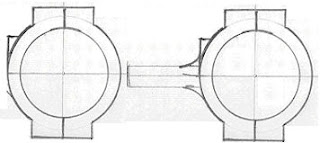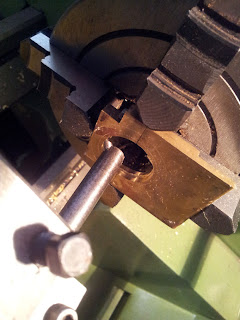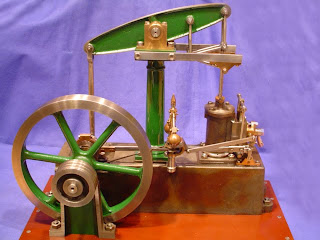Making The Eccentric - Valve Connecting Rod
The
connecting rod was made from some scrap sheet of the right thickness as
I did not have the correct MS flat to the Stuart specification i.e.
1/4" x 3/32" (6.35 x 2.4mm). I cut a longer piece than necessary to
allow for final fitting. To cut it I used my favourite 'file handle'
grip hacksaw. It is an ugly but ancient tool, rather like myself some
would say, but I have a soft spot for it as it belonged originally to my
grandfather, and he died in the late 1950s aged 72, so it has earned
it's keep over the years.
 |
| Initial Cutting of Connecting Rod Blank |
As I was cutting obviously I reached the limit of
the effective sawing which was restricted by the length of the hacksaw
frame (I am using a coarse 18tpi 10" (250mm) blade. I can get away with
a coarse blade as I am cutting at a low angle, it is important for
accurate work and to prevent blade breaking that there are always at
least three teeth in contact with the work at all times. In order to
overcome the problem the blade is turned through 90
º and now I can carry on cutting for as long as I like.
 |
| Blade Turned Through 90º
|
Here is the strip blank cut
together with the HI Tech tools I used. The cutting took me around 4
minutes in total. The age of the Hacksaw really shows but it is capable
of quite accurate work. By the way, these tools except for the
stainless rule, were salvaged from the fire and refurbished, I fitted a
new (old) handle to the hacksaw.
 |
| Tools Used To Cut Blank |
 |
| 'Nose' of Toolmakers Clamp seen at Upper Left. |
Next
I draw filed the flat sides of the blank as I was going to mill it to
near width later. The picture below shows the blank supported on a 12
mm square bar in my small bench vice. The end was clamped with a
traditional toolmakers clamp, a very effective tool if used correctly,
unfortunately many users don't bother to set the jaws near parallel
before using. Tremendous clamping force can be applied.
I
used a number of files of increasingly fine teeth finishing with emery
cloth supported by a 10" flat file. I had to be careful to keep the
face flat and was reasonably successful.
 |
| Milling, Using a Ground Bar to Aid Vice |
|
I
then milled the edge roughly to size. The blank was supported on
narrow parallels but they were too thick for the vice to clamp so I used
an accurate ground bar (from an old, broken printer - what would we do
without Mr HP's scrap?) to act as a spacing clamp bar.
The
blank was too long for the vice so I had to mill half and then move it
along for the second half to be machined. Not precision but I was going
to file the edge eventually so I wasn't too worried.
After
finishing one edge I filed it straight by hand - it was only a few
thou' out anyway - and polished the first edge I then milled the second
edge.
 |
| Draw Filing Blank in Small Bench V |
The final job was to
file the blank to 1/4" width (6.35mm or 0.250"). As before this was
done with succession of files, getting finer as I went along. It was
then finished with emery as before I went from 150 emery down the grades
to 600 grade. which gave a reasonable finish to the part.
I
was pleased with the final blank as it was to within half a thou'
(0.0005") over it's length - see pictures below. This sort of accuracy
is not necessary on such a component, after all it could be shaped like a
Chines Dragon for all that matters, but I like to get a job right if I
can without too much hassle.
Once
it was to size It was a simple task to transfer the holes from the
strap. I did that by glueing the parts together with Loctite and using
the holes in the strap as a drill guide. I would normally use a clamp
but this component is too small.
Images
showing the width of the connecting rod at both ends and the centre,
which is 0.005" narrower. I don't think that I'll worry about that!
 |
| Width at 'Top' End |
 |
| Width at Middle. |
 |
| Width at 'Bottom' end. |
A result!
It
took around 30 minutes to get here but much of that time was taken up
by getting a good finish on the blank, and drilling etc. which I would
have had to have done on MS flat a real plus was that I didn't have to
pay excessive postal costs and wait three or four days for it's
arrival. By recycling old material I was able to carry on the work in
hand quickly, saved myself money, had the satisfying warmth of a job
well done plus I did a bit for the environment. The photographic time
was extra.


















